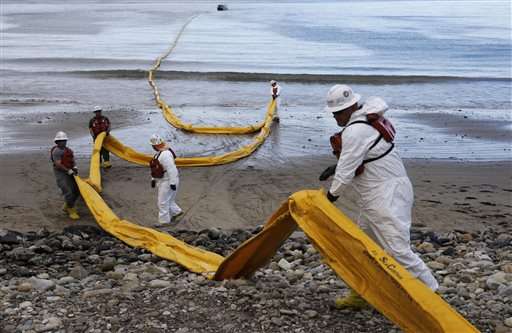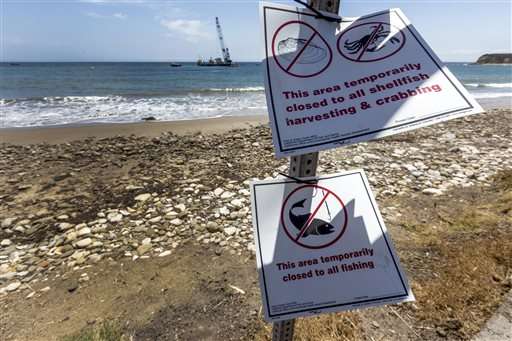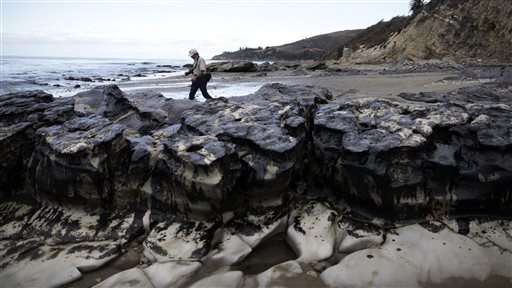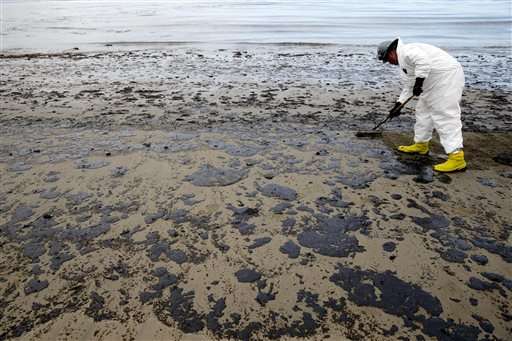Workers clean up oil spill on California beaches by hand

Along a stretch of beach heavily marred by a crude oil spill, workers in hard hats and white protective suits use wire brushes and putty knives to scrape the black liquid off cobblestones and cliff faces.
The painstaking task at Refugio State Beach marks a new front in the cleanup after an underground pipeline leaked last month and released up to 101,000 gallons of oil, about 21,000 gallons of which flowed into a storm drain, sullied the beach and washed out to sea. Because the region is home to threatened shorebirds and cultural resources, a decision was made early on to clean oil-stained beaches the old-fashioned way by using hand tools instead of heavy equipment or chemicals.
The environmental toll from the largest coastal spill in California in 25 years is still being tallied. Progress has been made in corralling the slick in the ocean and removing flecks of oil on sandy beaches.
Scrubbing rocks by hand will take time, however. "It's a very labor-intensive process, but that's where we're at now," Carl Childs of the National Oceanic and Atmospheric Administration, one of several agencies involved in the cleanup, said recently.
There's no timetable for when the cleanup will end. The effort so far has cost at least $65 million, which is being paid for by Texas-based Plains All American Pipeline. A heavily corroded section of Plains' 10-mile pipeline that moves oil from offshore rigs to inland refineries ruptured on May 19, causing two state beaches to close and prompting a fishing ban. One of the beaches, El Capitan State Beach, is set to reopen next week.
The spill blackened a section of the Santa Barbara County coastline that was also fouled during the 1969 offshore oil-platform blowout that spewed an estimated three million gallons of crude, killing thousands of birds and other animals.
Cleanup techniques have evolved since the 1969 disaster that helped usher in a new era of conservation. Back then, crews used straw to soak up oily sand. That's no longer done because straw is hard to pick up and removing too much sand can harm a beach.
In the latest spill, workers shoveled tar balls and contaminated sand into plastic bags that were then carried away for disposal. They had to be careful not to disturb populations of western snowy plovers that were in the middle of their breeding season.

"We're more concerned about the impact of the cleanup doing more injury than the oil did originally," said Kim McCleneghan of the state Department of Fish and Wildlife, who responded to both spills.
About 91 percent of 97 miles of coastline—mostly sandy beaches—surveyed by teams of experts from various federal and state agencies has been given the all-clear.
Significant work remains to clean oil-covered cobblestones and boulders dotting beaches. Workers scrape rocks until an oil stain remains. That can't be scrubbed off and must wear away naturally with time, McCleneghan said.
Once the expert teams are satisfied with the cleanliness of a beach or stone, monitoring continues to make sure there's no setback.
Santa Barbara County is home to one of the largest naturally occurring oil seeps in the world where thousands of gallons of oil ooze from cracks in the seafloor every day.
Frequently, the sticky substance ends up on the soles of swimmers and surfers. The natural seeps generally flow at a low rate unlike significant accidental spills, which release large volumes of oil at once. Oil fingerprinting can distinguish natural seeps from spills.

Crews are removing oil no matter if it came from the pipeline or if it occurred naturally, said Wade Bryant, senior environmental scientist at CK Associates, an environmental consulting group.
The cause of the spill remains under investigation. Earlier this week, Plains completed flushing the idled pipeline, a process that should allow for a more precise calculation of how much oil escaped.
Compared with the 1969 spill, the environmental damage in the latest episode has been much less severe. Nearly 300 dead birds and marine mammals have been recovered so far. Dozens more were rescued and are rehabilitating.

Michael Ziccardi, who heads the Oiled Wildlife Care Network at the University of California, Davis, said he's puzzled by the seemingly heavy toll on marine mammals, especially sea lions. Necropsies should help scientists determine if they died from the spill or other causes, he said.
Scientists hired by the state have spent several weeks documenting the effects of the spill on the environment and ecosystem. A preliminary analysis isn't expected for several months.
"It doesn't look like it's going to be catastrophic. But that doesn't mean there's not going to be damage," said Pete Raimondi of the University of California, Santa Cruz, who is studying the potential effects on mussels, abalone and sea stars in tide pools.
© 2015 The Associated Press. All rights reserved.





















